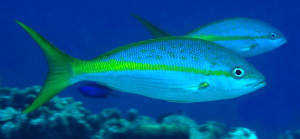“It’s kind of a funny thing to say that we would conserve for fish pee,” says study author Jake Allgeier, a postdoctoral researcher at the University of Washington. “But it is hopefully setting a precedent to think about these reefs differently.”
Nearly 2,000 years ago, the Roman emperor Vespasian taxed the sale of human urine, then a valuable industrial ingredient. When his son objected, the emperor held a gold coin to his nose, asking whether it smelled—arguing that money was money, no matter its source.
Perhaps Vespasian would have been a great marine biologist; when it comes to nutrients in coral reefs, he’s absolutely right. In fact, coral reefs wouldn’t be stunning havens for biodiversity without one key nutrient source: fish urine.

The trouble is, humans like to eat reefs’ best recyclers: the biggest, and biggest bladdered, fish atop the food chain. And the unsustainable pursuit of that protein comes at a cost. A study published on Tuesday in Nature Communications reveals that fishing can remove nearly half of coral reefs’ fish-driven recycling—underscoring the importance of large fish, and in particular large predators, in the post-food chain.
URINE FOR A TREAT
Allgeier has spent years studying pee, determining in incredible detail how the fish and invertebrates of the Caribbean urinate. His number one research focus, along with other groundbreaking studies over the last 30 years, reveals a surprising truth: that reefs are urine-soaked wonders.
Whether its phosphorus from their anuses or ammonium from their gills, fish spritz reefs with nutrients in just the right ratio and form for corals. This recycling is crucial since many of the world’s coral reefs don’t get much in the way of new nutrients. Nutrients flow up the ecosystem in the form of food—and back down again out the back end.
“We’re used to hearing about excess nutrients, and we’re forgetting about ecosystems where nutrients are hard to come by,” says University of Georgia ecologist Amy Rosemond, one of Allgeier’s mentors. “When you’re talking about this tight cycling on a reef, these biologically available nutrients are mainly coming from fish excretion.”
“It’s the same story with tropical forests: how can these forests be so productive with having so few nutrients in the soil?” says Michael Vanni, a freshwater ecologist at Miami University of Ohio who wasn’t involved with the study. “It’s because they’re so efficient at recycling.”
Tracking this recycling, however, is hard work, despite the stunning scenery.
For years, Allgeier started his days on the Bahamas’ Abaco Island by trapping fish and then placing them in seawater-filled plastic bags. By tracking the water’s chemical makeup before and after, Allgeier could determine how much a given fish peed in the pool. But since the fish’s bodies also act as nutrient reservoirs, Allgeier also had to freeze-dry and grind up the fish into analyzable powders.
“It’s nasty [and] messy,” says Allgeier. “You have talcum powder fish bits in your eyebrows.”
The largest specimen Allgeier ever caught and processed was a green moray (Gymnothorax funebris) more than 3.3 feet (1 meter) long.
PHOTOGRAPH BY MICHAEL PATRICK O’NEILL, ALAMY
Meanwhile, study coauthors Abel Valdivia and Courtney Cox spent years collecting snapshots of coral reefs from the Florida Keys to Cuba. The surveys, which cataloged 143 different species at 43 reefs, were painstaking. For each site, the duo counted and sized all the fish they could see in areas sometimes bigger than a basketball court, a process they’d repeat up to 10 times per reef.
“It’s a big relief when you see these data published,” says Valdivia, an ocean scientist with the Center for Biological Diversity.
FISHING FOR SOLUTIONS
With models and surveys in hand, the team saw that areas that were fished lost nearly half their fish-driven recycling. While fishing slightly reduced the number of species within the reefs, sheer species loss isn’t what slashed recycling. Instead, fishing mostly wielded influence by removing the biggest fish near the top of the food chain—keeping the species, but chipping away at their peeing ability.
“You can still have a species being present, but if you lose a lot of their biomass, you lose their function,” says Vanni. “[For] a lot of people, when they think of conservation, they think ‘number of species.’ It’s not that simple.”
While the study in and of itself doesn’t make policy recommendations, the finding suggests that fisheries would benefit from accounting for fish size in their regulations. Helping to preserve big fish—and their pee—would ensure sustainable nutrient flows for reefs worldwide, at a time when corals stare down the enormous challenge of climate change.
“So many times, we see negative feedbacks of human modification of systems, where we lose ecosystem services,” says Rosemond. “In this case, we can get value added.”
Source: Fish Pee, Coral’s Number One Nutrient Supply, Cut by Fishing
